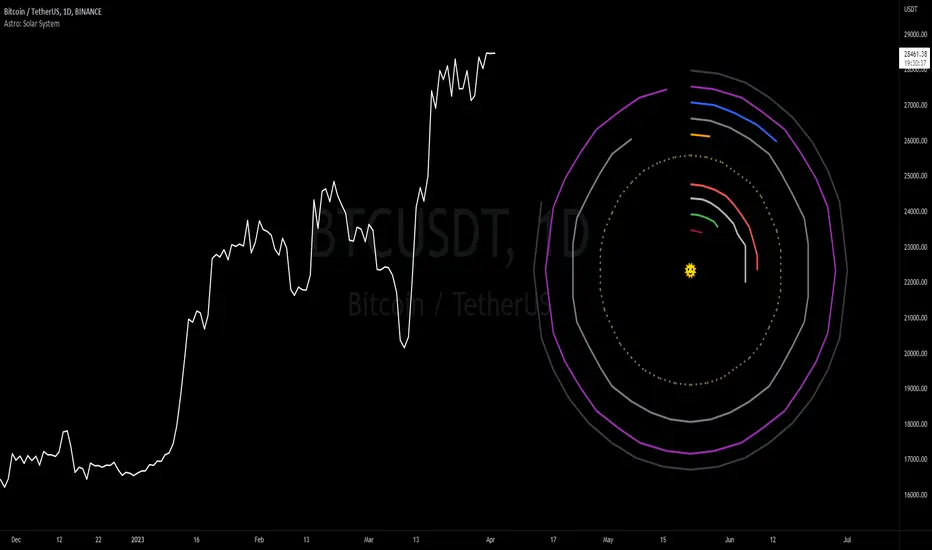OPEN-SOURCE SCRIPT
Güncellendi Astro: Solar System

A bird's eye view model of the solar system is a simplified representation of our planetary system as seen from above. It can be thought of as a two-dimensional map of the solar system, in which the planets are shown in their approximate heliocentric longitudinal positions relative to the Sun and each other.
In this model, the Sun is shown as a large, central emoji, with the planets arranged in orbits around it. The inner planets - Mercury, Venus, Earth, and Mars - are located close to the Sun and inside the asteroid belt, while the outer planets - Jupiter, Saturn, Uranus, Neptune, and Pluto- are located farther out.
In a bird's eye view model, some of the details of the solar system are necessarily left out or simplified. For example, the distances between the planets are not to scale, and the orbits are shown as perfect circles rather than the elliptical shapes they actually are. Nonetheless, this model can provide a useful visual real-time representation of the relative heliocentric longitudinal positions (aspects) of the planets in our solar system.
🏅 Shoutout to LuxAlgo for the circle code!
In this model, the Sun is shown as a large, central emoji, with the planets arranged in orbits around it. The inner planets - Mercury, Venus, Earth, and Mars - are located close to the Sun and inside the asteroid belt, while the outer planets - Jupiter, Saturn, Uranus, Neptune, and Pluto- are located farther out.
In a bird's eye view model, some of the details of the solar system are necessarily left out or simplified. For example, the distances between the planets are not to scale, and the orbits are shown as perfect circles rather than the elliptical shapes they actually are. Nonetheless, this model can provide a useful visual real-time representation of the relative heliocentric longitudinal positions (aspects) of the planets in our solar system.
🏅 Shoutout to LuxAlgo for the circle code!
Sürüm Notları
Update: minor GUI/settings changesSürüm Notları
Update: minor GUI/settings changesSürüm Notları
Update: Fixed timestamp error that prevented the indicator from loading. Thank you to the traders who reported issues (phunkalunk gets my credit for being the first) and the TradingView Tier 1 & 2 Support Teams for helping resolve it quickly! Please remove, refresh, and reload to receive this update. Açık kaynak kodlu komut dosyası
Gerçek TradingView ruhuyla, bu komut dosyasının mimarı, yatırımcıların işlevselliğini inceleyip doğrulayabilmesi için onu açık kaynaklı hale getirdi. Yazarı tebrik ederiz! Ücretsiz olarak kullanabilseniz de, kodu yeniden yayınlamanın Topluluk Kurallarımıza tabi olduğunu unutmayın.
Made w/ ❤ by @BarefootJoey ✌💗📈
Feragatname
Bilgiler ve yayınlar, TradingView tarafından sağlanan veya onaylanan finansal, yatırım, alım satım veya diğer türden tavsiye veya öneriler anlamına gelmez ve teşkil etmez. Kullanım Koşulları bölümünde daha fazlasını okuyun.
Açık kaynak kodlu komut dosyası
Gerçek TradingView ruhuyla, bu komut dosyasının mimarı, yatırımcıların işlevselliğini inceleyip doğrulayabilmesi için onu açık kaynaklı hale getirdi. Yazarı tebrik ederiz! Ücretsiz olarak kullanabilseniz de, kodu yeniden yayınlamanın Topluluk Kurallarımıza tabi olduğunu unutmayın.
Made w/ ❤ by @BarefootJoey ✌💗📈
Feragatname
Bilgiler ve yayınlar, TradingView tarafından sağlanan veya onaylanan finansal, yatırım, alım satım veya diğer türden tavsiye veya öneriler anlamına gelmez ve teşkil etmez. Kullanım Koşulları bölümünde daha fazlasını okuyun.